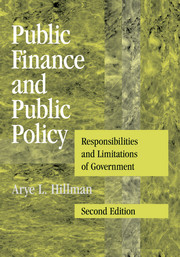Book contents
- Frontmatter
- Contents
- Preface to the Second Edition
- 1 MARKETS AND GOVERNMENTS
- 2 INSTITUTIONS AND GOVERNANCE
- 3 PUBLIC GOODS
- 4 PUBLIC FINANCE FOR PUBLIC GOODS
- 5 MARKET CORRECTIONS
- 6 VOTING
- 7 SOCIAL JUSTICE
- 8 ENTITLEMENTS
- 9 CHOICE OF TAXATION
- 10 THE NEED FOR GOVERNMENT
- TOPICS FOR DISCUSSION
- Author Index
- Subject Index
- References
4 - PUBLIC FINANCE FOR PUBLIC GOODS
- Frontmatter
- Contents
- Preface to the Second Edition
- 1 MARKETS AND GOVERNMENTS
- 2 INSTITUTIONS AND GOVERNANCE
- 3 PUBLIC GOODS
- 4 PUBLIC FINANCE FOR PUBLIC GOODS
- 5 MARKET CORRECTIONS
- 6 VOTING
- 7 SOCIAL JUSTICE
- 8 ENTITLEMENTS
- 9 CHOICE OF TAXATION
- 10 THE NEED FOR GOVERNMENT
- TOPICS FOR DISCUSSION
- Author Index
- Subject Index
- References
Summary
Societies assign responsibilities for financing public goods to governments because of the asymmetric-information problem and the associated incentives to misrepresent preferences (or free ride). In this chapter, we study the financing of public goods by governments. Our focus is on efficiency rather than social justice.
In investigating how efficient public finance for public goods might be achieved, we face practical impediments. Political and bureaucratic principal–agent problems can prevent efficient outcomes in the public interest. Our conclusion from chapter 3 is that governments remain subject to the asymmetric-information problem; governments cannot observe and so do not know the true subjective benefits ∑MB that public goods provide to a population.
Without revelation of personal preferences through the Clarke tax, we could hope that governments have nonetheless been successful in using cost-benefit analysis to approximate ∑MB. That is, ideally we would want governments to have used cost-benefit analysis to attempt to identify the efficient public spending that the government's taxes will finance. Because of the principal–agent problems, we cannot predict that attempts at cost-benefit analysis will necessary have been made; indeed, in practice, decisions regarding public spending are political and are revealed when a government presents its budget.
The Tiebout locational-choice mechanism is based on choice among governments. The asymmetric-information problem is solved when people voluntarily group themselves into government jurisdictions according to their preferences for different public goods.
- Type
- Chapter
- Information
- Public Finance and Public PolicyResponsibilities and Limitations of Government, pp. 243 - 306Publisher: Cambridge University PressPrint publication year: 2009



